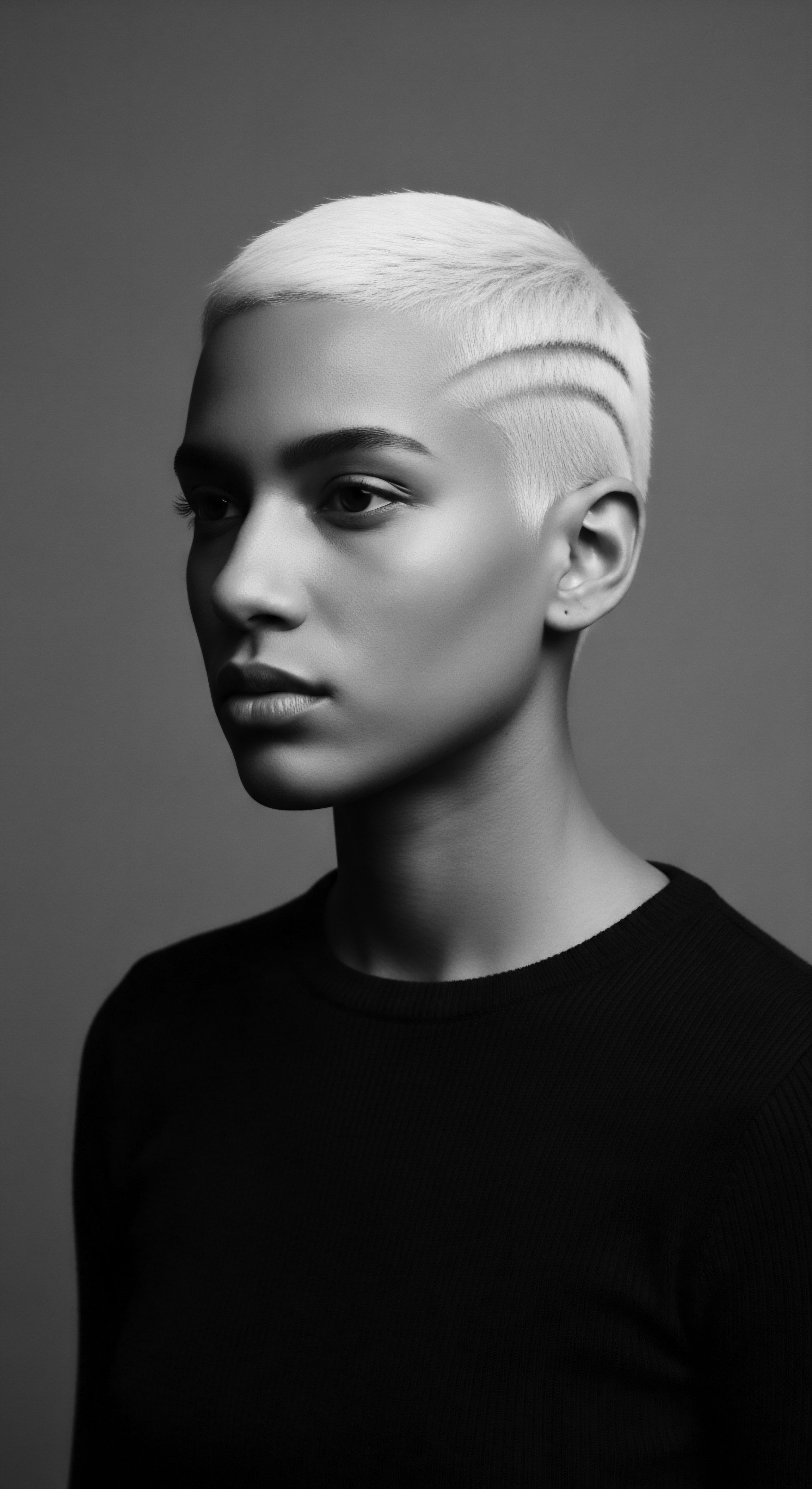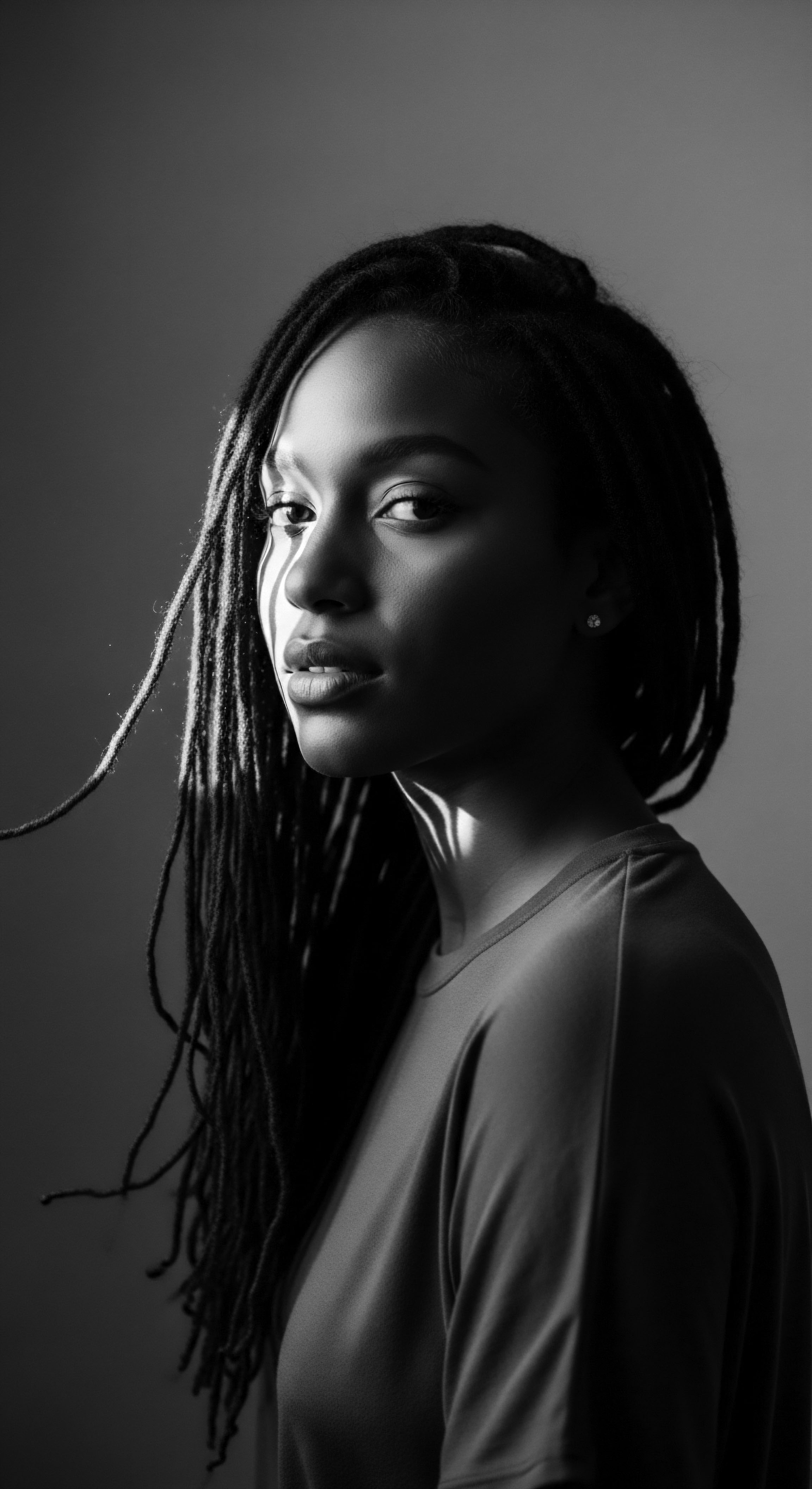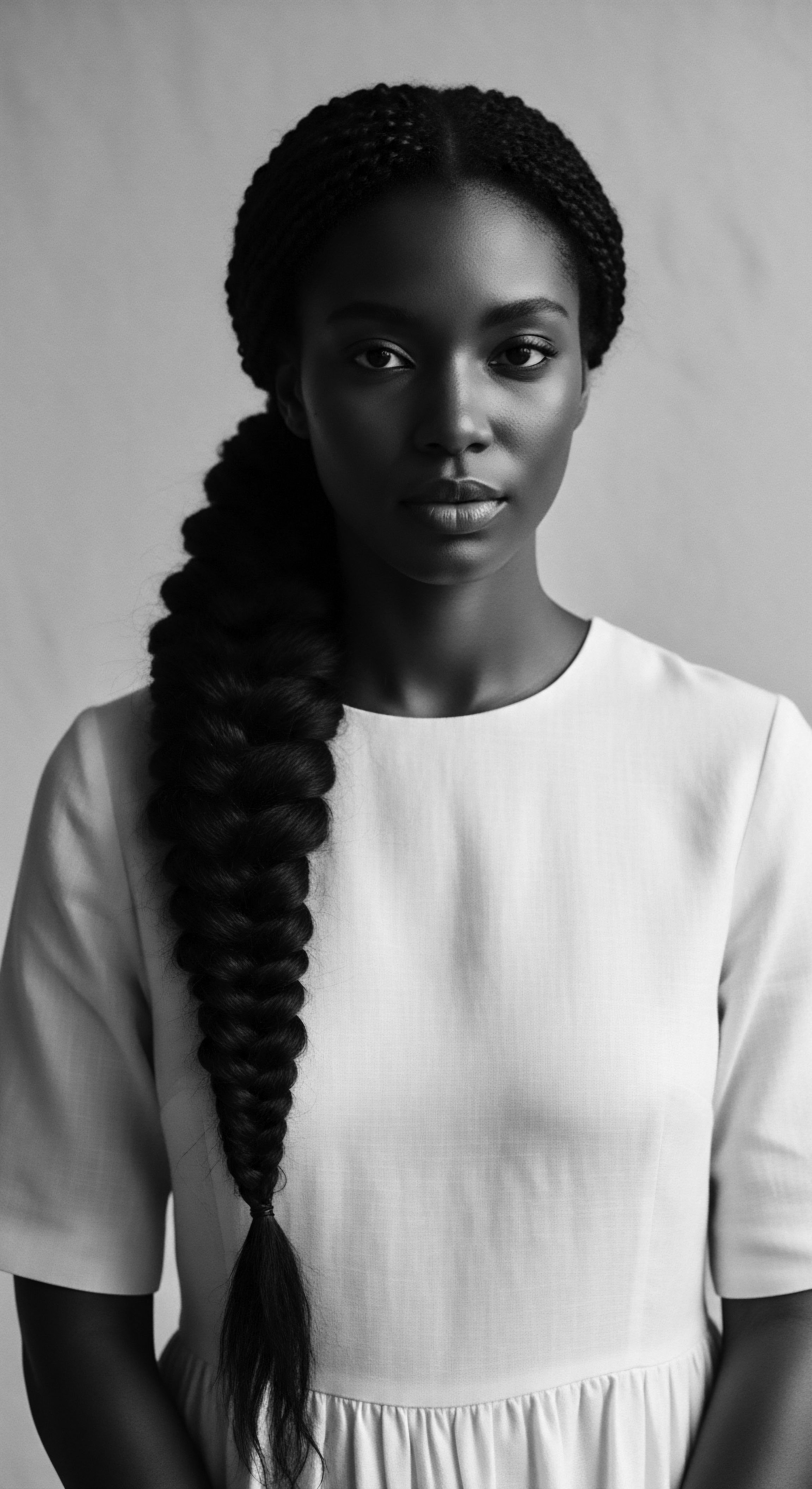
Roots
There exists a certain quiet reverence within the act of tending to textured hair, a dialogue between the present hand and the ancient past. For those of us with coils, kinks, and waves that defy simple definition, our hair is more than keratin and disulfide bonds; it is a living chronicle, a flowing river of inherited wisdom. It speaks of journeys across continents, of resistance whispered through strands, of beauty forged in the crucible of adaptation and cultural expression. To understand what cultural heritage textured hair care holds for Black and mixed-race identities is to embark upon a profound exploration of self, lineage, and the very cosmology that cradles our existence.

The Unseen Architecture of Ancestry
At its elemental core, textured hair presents a biological marvel. Unlike its straighter counterparts, the follicular structure of coily hair, for instance, is often elliptical or flattened, creating a helical growth pattern. This distinctive shape, along with the distribution of disulfide bonds and melanin granules, contributes to the spring, strength, and indeed, the sometimes delicate nature of each individual strand.
This particular morphology is not a random occurrence; it is a testament to aeons of human adaptation, a phenotypic expression shaped by environment and lineage. Consider the very pigment, melanin, which provides the deep hues often seen in textured hair; beyond color, it contributes to the hair’s inherent resilience against environmental stressors, an enduring gift from our forebears.
Textured hair, at its biological base, is a living record of adaptation and ancestral gift, its structure a testament to aeons of human experience.
Throughout historical eras, particularly within various African societies, hair morphology was often observed with keen insight, though perhaps not through the precise lens of modern microscopy. What was understood was its behavior, its needs, and its capacity for symbolic expression. This intuitive understanding formed the bedrock of care practices, passed down through generations. The very terms we use today to describe hair types, while sometimes rooted in colonial categorizations, have found new meaning within Black and mixed-race communities, reshaped to celebrate the diversity of textures rather than diminish them.

Beyond the Follicle Defining Hair’s Place
Across vast stretches of pre-colonial African societies, hair was an undeniable marker of identity. It spoke volumes without uttering a word. A person’s hairstyle could indicate their age, marital status, tribal affiliation, social standing, or even their spiritual disposition. These distinctions were not superficial; they were deeply interwoven with societal fabric, reflecting communal values and belief systems.
For instance, among the Wolof people of Senegal, specific braiding patterns, known as ‘dada,’ traditionally signaled a woman’s marital status and readiness for motherhood. This tradition, passed down through matriarchal lines, demonstrates how hair care was a pedagogical act, teaching not just styling techniques but also the cultural norms and expectations tied to a woman’s life progression (Byrd & Tharps, 2001).
The tools employed in these ancient rituals were often objects of beauty and utility. Combs carved from wood or bone, adorned with intricate designs, were not merely implements for detangling; they were extensions of artistic expression, embodying cultural motifs and sometimes holding spiritual significance. The practice of oiling and massaging the scalp, using natural emollients extracted from local botanicals, spoke to a deep understanding of scalp health and hair vitality, practices now validated by contemporary trichology.

How do Ancestral Hair Classifications Inform Modern Understanding?
While modern hair classification systems, such as those popularized by Andre Walker or Fia, primarily categorize hair by curl pattern (from straight to coily), historical African societies often classified hair based on social or spiritual significance, or even ritualistic readiness. This traditional approach prioritized the hair’s role within community life and cosmology over purely phenotypic descriptions. For example, some groups might recognize hair worn long and flowing as a sign of mourning or wisdom, while tightly coiled styles might signify battle readiness or a specific ceremonial status. Understanding these ancestral frameworks offers a deeper appreciation for the nuanced ways hair was perceived and cared for, moving beyond simple aesthetics to embrace its multifaceted cultural roles.
| Ancient Observation Hair as a conduit to the divine or ancestral spirits, requiring gentle handling. |
| Modern Scientific Correlate The scalp’s rich vascularity and nerve endings, making it a sensitive area of the body. |
| Ancient Observation The recognition of hair’s varied textures and need for diverse styling. |
| Modern Scientific Correlate The molecular differences in cortical cells and disulfide bond distribution across hair types. |
| Ancient Observation Emphasis on natural oils and plant extracts for hair strength and health. |
| Modern Scientific Correlate The role of lipids and emollients in maintaining cuticle integrity and moisture balance. |
| Ancient Observation A continuous dialogue unfolds between ancient wisdom and contemporary scientific discovery, revealing the enduring relevance of traditional care. |
- Cosmology ❉ Hair was seen as a direct link between the individual and the cosmos, drawing energy from the heavens.
- Community Identity ❉ Hairstyles often identified one’s tribal lineage, social standing, or age group.
- Protection ❉ Braiding and coiling styles were not only decorative but offered protection from the elements.

Ritual
The journey of textured hair care from the source of its being to the hands that tend it is a rich tapestry woven with communal practices and personal moments of profound connection. It is within these living traditions that the heart of its cultural heritage truly beats. The routines, the tools, the very rhythm of care, are not mere acts of hygiene or vanity; they are rituals, deeply imbued with ancestral wisdom and societal meaning.

The Sacred Act of Adornment
Throughout the African diaspora, the art of styling textured hair has served as a powerful language, transmitting stories, affirming identity, and resisting dominant narratives that sought to diminish its inherent beauty. Braiding, in its myriad forms, stands as a prime example of this living legacy. From the intricate cornrows of West Africa, which could sometimes depict maps for escaping slavery, to the sculptural updos seen in ancient Egyptian reliefs, these styles were, and remain, acts of creation.
The communal aspect of hair braiding, often occurring amongst women, became a sacred space for sharing stories, transmitting knowledge, and fostering bonds of solidarity. This shared experience, often lasting hours, created a palpable sense of belonging and reinforced social connections.
The ritual of hair care has consistently served as a powerful language, transmitting cultural memory, forging identity, and affirming communal bonds across generations.
Natural styling techniques, too, carry the weight of ages. Coiling, twisting, knotting – these methods predate modern hair product innovations, relying on an understanding of the hair’s inherent structure and its response to moisture and manipulation. These techniques were not developed in isolation; they arose from generations of observation, experimentation with local botanicals, and a deep, intuitive respect for the hair’s organic tendencies. The very act of preparing the hair, cleansing with natural lathers, conditioning with plant-derived oils, and then patiently shaping it, mirrors ancient agrarian cycles of preparing the earth, nurturing its growth, and harvesting its yield.

How do Traditional Tools Reflect Ancestral Ingenuity?
The tools of textured hair care, from meticulously crafted combs to a simple piece of string or fabric, are not accidental implements. They are expressions of ancestral ingenuity, designed with a deep understanding of hair’s unique qualities. Early combs, for example, often possessed wider teeth and sturdy construction, suitable for detangling dense, coily textures without breakage.
Some were adorned with symbols, suggesting a significance beyond mere function—perhaps totemic representations, spiritual motifs, or markers of status. The very use of hands for detangling and styling, which remains a cornerstone of textured hair care, points to the intimate, tactile connection maintained throughout time, a gentle dialogue between person and strand.
Wigs and hair extensions, often perceived as contemporary accessories, hold a venerable place in the heritage of textured hair. In ancient Egypt, elaborate wigs crafted from human hair, wool, or vegetable fibers were symbols of wealth, status, and religious observance, worn by both men and women. These were not merely cosmetic additions; they served practical purposes of sun protection and hygiene, while also allowing for diverse and complex expressions of identity without altering one’s natural hair. This historical lineage reminds us that the desire for aesthetic transformation and protection through hair adornment is a continuity, linking modern practices to ancient traditions.

The Nighttime Sanctuary Rituals of Protection
A particularly poignant aspect of textured hair care heritage lies in the nighttime sanctuary – the rituals of protection undertaken before sleep. The practice of wrapping hair, covering it with cloths, or later, bonnets made from silk or satin, emerged from a practical necessity ❉ to shield delicate strands from friction, tangling, and moisture loss during slumber. This tradition gained added significance during the transatlantic slave trade, where simple head coverings, often made from scrap fabric, became a means of maintaining dignity and preserving hair that was often neglected or forcefully shorn. The bonnet, therefore, is not simply an accessory; it is a symbol of resilience, self-care, and the reclamation of a sacred space for personal upkeep, a quiet act of defiance against systems that sought to strip away personhood.
| Traditional Practice Communal braiding gatherings for social bonding and knowledge sharing. |
| Modern Application and Cultural Resonance Hair salons and online communities serving as cultural hubs and spaces of collective care. |
| Traditional Practice Use of natural plant-based oils and butters for conditioning. |
| Modern Application and Cultural Resonance The widespread adoption of natural ingredient-focused product lines and DIY hair recipes. |
| Traditional Practice Head coverings and wraps for hair protection and adornment. |
| Modern Application and Cultural Resonance The continued use of bonnets, scarves, and decorative wraps for both protection and style. |
| Traditional Practice The enduring patterns of hair care rituals reflect a profound connection to ancestry and community, bridging historical needs with contemporary expressions. |
The selection of ingredients for hair care, too, carries a deep historical resonance. Before the advent of mass-produced chemical concoctions, African societies utilized a pharmacopoeia of natural elements. Shea butter, sourced from the karite tree, offered deep moisture; black soap, crafted from plantain skins and palm oil, provided gentle cleansing; and various essential oils, derived from indigenous flora, contributed to scalp health and aromatic appeal.
These ingredients were not chosen haphazardly; their properties were understood through generations of empirical observation, a holistic science passed down through oral tradition. Their continued use today represents a conscious choice to honor that ancestral wisdom, a quiet affirmation of a heritage that values natural nourishment and reverence for the earth’s bounty.

Relay
The cultural heritage of textured hair care is not a static relic of the past; it is a dynamic, living system, continually relaying its wisdom across generations, adapting to new realities, and serving as a powerful medium for identity and expression. This complex interplay of historical practice, contemporary science, and ongoing social discourse elevates textured hair beyond mere aesthetics, positioning it as a profound site of cultural affirmation and self-discovery.

Identity Forged in Strands
For Black and mixed-race individuals, hair has historically occupied a contentious space within societies structured by colonial and anti-Black ideals. The systematic denigration of textured hair, often deemed unruly or unprofessional, led to generations of chemical alteration—straightening, relaxing—as a means of conforming to imposed Eurocentric beauty standards. The very act of caring for one’s textured hair under such pressures became an act of profound resistance, a quiet refusal to abandon one’s innate characteristics. This resistance, often expressed through the enduring presence of natural styles in private spaces, laid the groundwork for later public movements.
The rise of the natural hair movement in the latter half of the 20th century and its resurgence in the 21st century can be seen not as a new phenomenon, but as a continuation of this ancestral spirit of self-determination. It represents a collective re-engagement with historical forms of care and styling, a conscious choice to divest from oppressive beauty norms and reclaim an aesthetic rooted in ancestral beauty. This movement, gaining momentum through digital spaces and shared experience, has fostered a global community, allowing for an accelerated exchange of knowledge and a powerful reinforcement of collective identity.

What Scientific Insights Affirm Traditional Hair Practices?
Modern trichology offers compelling validation for many long-standing traditional textured hair care practices. For example, the ancestral emphasis on protective styling, such as braids, twists, and locs, finds scientific backing in its ability to reduce manipulation, minimize breakage, and shield delicate hair from environmental stressors. Similarly, the traditional preference for natural oils and butters like shea butter or coconut oil is supported by scientific studies on their molecular structure, demonstrating their capacity to penetrate the hair shaft, seal moisture, and improve elasticity (Gavazzoni Dias, 2015). This confluence of ancient wisdom and contemporary understanding highlights a profound, often intuitive, knowledge base that has been passed down through generations, continuously refined through lived experience.
- Low Manipulation ❉ Protective styles reduce constant touching and styling, lessening mechanical stress on the hair.
- Moisture Retention ❉ Braids and twists help seal in moisture, particularly important for textured hair prone to dryness.
- Scalp Health ❉ Traditional oils and scalp massages promote circulation and a healthy environment for hair growth.

The Economic Impact of Hair Identity
The deep cultural significance of textured hair has also generated a vibrant economic ecosystem, a testament to its enduring value. From small-scale vendors selling traditional ingredients to large corporations producing specialized products, the market for Black and mixed-race hair care is a significant and continually expanding domain. This economic activity is not merely commercial; it is an extension of cultural pride, with consumers seeking products that honor their unique hair needs and cultural background. The demand for specific ingredients, such as African black soap or various botanical oils, has created pathways for economic agency within communities that source and process these elements, bridging tradition with modern commerce.
Furthermore, the digital age has provided unprecedented platforms for sharing knowledge and fostering community around textured hair care. Online forums, social media groups, and video tutorials have become the modern-day equivalents of communal braiding circles, allowing for the rapid dissemination of techniques, product reviews, and personal narratives. This decentralized flow of information empowers individuals to experiment, learn, and adapt their care regimens, continually refreshing and reinforcing the heritage of textured hair care in innovative ways. It also challenges previous gatekeepers of beauty standards, asserting a self-defined aesthetic that celebrates diversity and authenticity.

How does Hair Identity Contribute to Collective Resilience?
The journey of textured hair, particularly for Black and mixed-race individuals, is deeply intertwined with narratives of resilience. Facing historical pressures to conform, the choice to wear one’s hair in its natural state, or to adopt styles that defy mainstream norms, has become a powerful act of self-acceptance and cultural pride. This personal choice, multiplied across countless individuals, contributes to a collective affirmation of identity, reinforcing the beauty and validity of textured hair. It counters historical narratives of shame, fostering a sense of belonging and solidarity that transcends geographical boundaries, linking individuals through a shared appreciation for their unique strands and the heritage they embody.

Reflection
In the quiet contemplation of a single strand of textured hair, one discovers an expansive world – a legacy of fortitude, artistic expression, and profound identity. The journey of understanding what cultural heritage textured hair care holds for Black and mixed-race identities is not a finite exploration; it is a continuous unfolding, a deepening of appreciation for the ingenuity of our ancestors and the resilience of our communities. Each curl, each wave, each intricate coil carries within it the echoes of countless hands that have tended, adorned, and celebrated this crowning glory.
It is a living archive, breathing with stories of adaptation, resistance, and joy. To care for textured hair, then, is to participate in an enduring tradition, to honor a vital aspect of one’s being, and to contribute to the living library that ensures this rich heritage is passed forward, vibrant and unbound, for generations to come.

References
- Byrd, A. D. & Tharps, L. D. (2001). Hair Story Untangling the Roots of Black Hair in America. St. Martin’s Griffin.
- Gavazzoni Dias, M. F. R. (2015). Hair Cosmetics ❉ An Overview. International Journal of Trichology, 7(1), 2-15.
- Mercer, K. (1994). Welcome to the Jungle New Positions in Black Cultural Studies. Routledge.
- hooks, b. (1988). Ain’t I A Woman Black Women and Feminism. South End Press.
- Akbar, N. (2017). The Science of the Black Hair Follicle A Clinical Guide. Xlibris Corporation.
